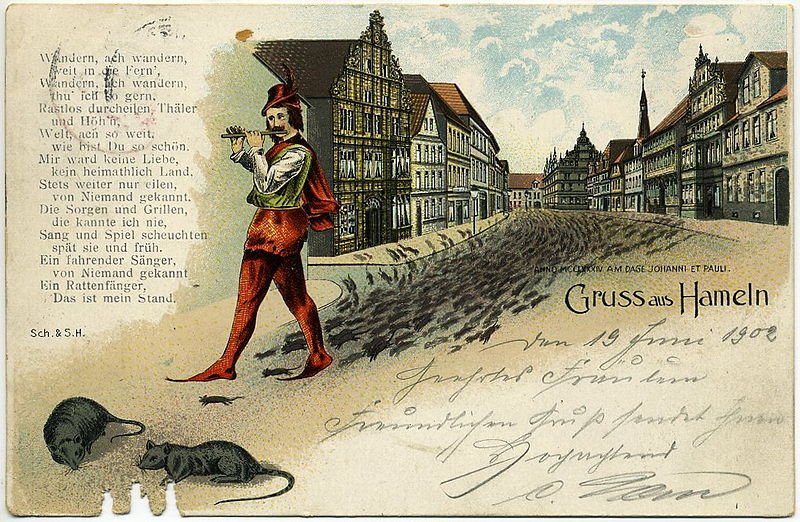Unraveling The Mystery Behind The Perplexing Story Of Pied Piper Of Hamelin
Ellen Lloyd – MessageToEagle.com – There was something magical about the sound of his pipe. It had a strange effect on the 130 children who followed him into the woods. They entered the cave and were never seen again. Something strange and unexplained happened in the small village of medieval Hamelin hundreds of years ago. How could a man lure all those children into a trap and how could they vanish without a trace?
Did you ever hear the story of Pied Piper of Hamelin when you were a child? The story is still often told to children across the world and it’s quite a disturbing tale. As it so often is with folktales, there is, in fact, some truth in the Pied Piper story. If the story is based in reality, what did really transpire on that crucial day?
The Pied Piper of Hamelin, also known as Pan Piper, the Rat-Catcher of Hamelin is based on a legend from the town of Hamelin, Lower Saxony, Germany.
The mayor, in turn, promised to pay him for the removal of the rats. The piper accepted and played his magical pipe to lure the rats into the Weser River, where all but one drowned.
However, when the villagers refused to pay for the services he sought revenge. He played on his pipe that had magical powers affecting the children and led them away in the same way as he got rid of the rats. He lured 130 children into the woods where they entered a cave and were never to be seen again. One version of this disturbing story tells that three children remained behind.
One of them was lame and could not follow quickly enough, the second was deaf and followed the other children out of curiosity, and the last was blind and unable to see where he was going. These three informed the villagers of what had happened when they came out of the church. This version of the story spread as folklore and has appeared in the writings of Johann Wolfgang von Goethe, the Brothers Grimm, and Robert Browning, among others. The Pied Piper is also sometimes thought to have been, or associated with, the Norse God Odin or the Anglo-Saxon counterpart Woden.

What is interesting is that long before the Brothers Grimm chronicled the fairy tale in their anthology of stories, curious writings regarding the piper story appeared.
For example, a document from 1384 about Hamelin’s history states that an unrelated event took place “…100 years since our children left.” Dated to about 1440 C.E., another manuscript states: “In the year of 1284, on June 26…a piper, clothed in many kinds of colors, (there were) 130 children born in Hamelin were seduced, and lost at the place of execution near the hill.” It is also puzzling that none of the manuscripts mention of rats. Even today, the historical background of the Pied Piper’s legend can not be proved.
Among the various interpretations, reference to the colonization of East Europe starting from Low Germany is the most plausible one: The “Children of Hameln” would have been in those days citizens willing to emigrate being recruited by landowners to settle in Moravia, East Prussia, Pomerania or in the Teutonic Land. It is assumed that in past times all people of a town were referred to as “children of the town” or “town children” as is frequently done today.  Historian Ursula Sautter, citing the work of linguist Jurgen Udolph, offers this hypothesis in support of the emigration theory: “After the defeat of the Danes at the Battle of Bornhöved in 1227,” explains Udolph, “the region south of the Baltic Sea, which was then inhabited by Slavs, became available for colonization by the Germans.” The bishops and dukes of Pomerania, Brandenburg, Uckermark, and Prignitz sent out glib “locators,” medieval recruitment officers, offering rich rewards to those who were willing to move to the new lands.
Historian Ursula Sautter, citing the work of linguist Jurgen Udolph, offers this hypothesis in support of the emigration theory: “After the defeat of the Danes at the Battle of Bornhöved in 1227,” explains Udolph, “the region south of the Baltic Sea, which was then inhabited by Slavs, became available for colonization by the Germans.” The bishops and dukes of Pomerania, Brandenburg, Uckermark, and Prignitz sent out glib “locators,” medieval recruitment officers, offering rich rewards to those who were willing to move to the new lands.
Thousands of young adults from Lower Saxony and Westphalia headed east. And as evidence, about a dozen Westphalian place names show up in this area. Indeed there are five villages called Hindenburg running in a straight line from Westphalia to Pomerania, as well as three eastern Spiegelbergs and a trail of etymology from Beverungen south of Hamelin to Beveringen northwest of Berlin to Beweringen in modern Poland Several researchers have studied the Pied Piper story to unravel the mystery, but without any success.
Many theories have been put forward. Some suggest that children died of some natural causes such as disease or accident and that the Piper was a symbolic figure of Death.

There are also those who say the children died of natural causes. Analogous themes that are associated with this theory include the Dance of Death, Totentanz or Danse Macabre, a common medieval trope. Some of the scenarios that have been suggested as fitting this theory include that the children drowned in the river Weser, were killed in a landslide, or contracted some disease during an epidemic. Another modern interpretation reads the story as alluding to an event where Hamelin children were lured away by a pagan or heretic sect to forests near Coppenbrügge (the mysterious Koppen “hills” of the poem) for ritual dancing where they all perished during a sudden landslide or collapsing sinkhole.
Others have suggested that the children left Hamelin to be part of a pilgrimage, a military campaign, or even a new Children’s crusade (which is said to have occurred in 1212) but never returned to their parents. These theories see the unnamed Piper as their leader or a recruiting agent. The town’s people made up this story (instead of recording the facts) to avoid the wrath of the church or the king.
The identity of Pied Piper remains a mystery. We also do we know what happened to all those children who vanished and were never seen again. Ask yourself why 130 children would willingly follow a stranger into the woods… Perhaps we will never find out what happened, but think twice before you tell this story to your child next time…
Written by – Ellen Lloyd – MessageToEagle.com Senior Staff Writer
Copyright © MessageToeagle.com All rights reserved. This material may not be published, broadcast, rewritten or redistributed in whole or part without the express written permission of MessageToeagle.com
Expand for referencesReferences:
Stadt Hamel – Pied Piper
Wikipedia – Pied Piper Of Hemelin
University of Pittsburgh – The Pied Piper of Hameln
Related Posts
-
 How King Arthur Became One Of The Most Pervasive Legends Of All Time
No Comments | Feb 12, 2017
How King Arthur Became One Of The Most Pervasive Legends Of All Time
No Comments | Feb 12, 2017 -
 Chaneques: Mischievous Legendary Tricksters In Mexican Folklore
No Comments | Apr 14, 2020
Chaneques: Mischievous Legendary Tricksters In Mexican Folklore
No Comments | Apr 14, 2020 -
 Echo And Narcissus: Cursed Ability To Speak And Punishment Of Selfish Love And Vanity
No Comments | Feb 10, 2021
Echo And Narcissus: Cursed Ability To Speak And Punishment Of Selfish Love And Vanity
No Comments | Feb 10, 2021 -
 Tristan da Cunha: The Remotest Inhabited Island
No Comments | Mar 23, 2016
Tristan da Cunha: The Remotest Inhabited Island
No Comments | Mar 23, 2016 -
 Arimaspians: Mysterious Mighty Warrior People With One-Eye
No Comments | Mar 10, 2021
Arimaspians: Mysterious Mighty Warrior People With One-Eye
No Comments | Mar 10, 2021 -
 Supay: God Of Death And Underworld And Ruler Over Race Of Demons According to Inca Mythology
No Comments | Jun 1, 2016
Supay: God Of Death And Underworld And Ruler Over Race Of Demons According to Inca Mythology
No Comments | Jun 1, 2016 -
 Full Moon In Ancient Myths And Legends Of Our Ancestors
No Comments | Nov 14, 2016
Full Moon In Ancient Myths And Legends Of Our Ancestors
No Comments | Nov 14, 2016 -
 People With Blue Eyes Have One Common Ancestor Who Appeared 10,000 Years Ago
No Comments | Feb 24, 2017
People With Blue Eyes Have One Common Ancestor Who Appeared 10,000 Years Ago
No Comments | Feb 24, 2017 -
 Hathor – One Of Ancient Egypt’s Greatest Female Deities
No Comments | Jun 17, 2021
Hathor – One Of Ancient Egypt’s Greatest Female Deities
No Comments | Jun 17, 2021 -
 Timeless Mythical Beings Of Nordic Folklore: Sinister Dark Elves And Light Elves And Their Magical Ship ‘Skidbladnir’
No Comments | Oct 3, 2016
Timeless Mythical Beings Of Nordic Folklore: Sinister Dark Elves And Light Elves And Their Magical Ship ‘Skidbladnir’
No Comments | Oct 3, 2016
